Corporate Finance: Origin Energy WACC and Gearing Analysis
VerifiedAdded on 2021/05/31
|16
|2810
|87
Report
AI Summary
This report provides a comprehensive analysis of corporate finance principles, focusing on the Weighted Average Cost of Capital (WACC), gearing ratios, and capital structure. It begins with a calculation of WACC for Origin Energy Limited, detailing the cost of equity and cost of debt, and explaining how these components are combined. The report then explores the company's capital structure, including the weights of debt and equity, and calculates various gearing ratios like interest coverage ratio, debt to equity ratio, debt ratio, and equity ratio. The report discusses the difficulties associated with gearing ratios and the impact of high leverage. It delves into capital structure theory, comparing traditional approaches and highlighting the importance of finding an optimal capital structure to minimize WACC. Finally, the report offers recommendations for Origin Energy Limited's capital structure, weighing the pros and cons of debt and equity financing to guide the company's financial strategy.
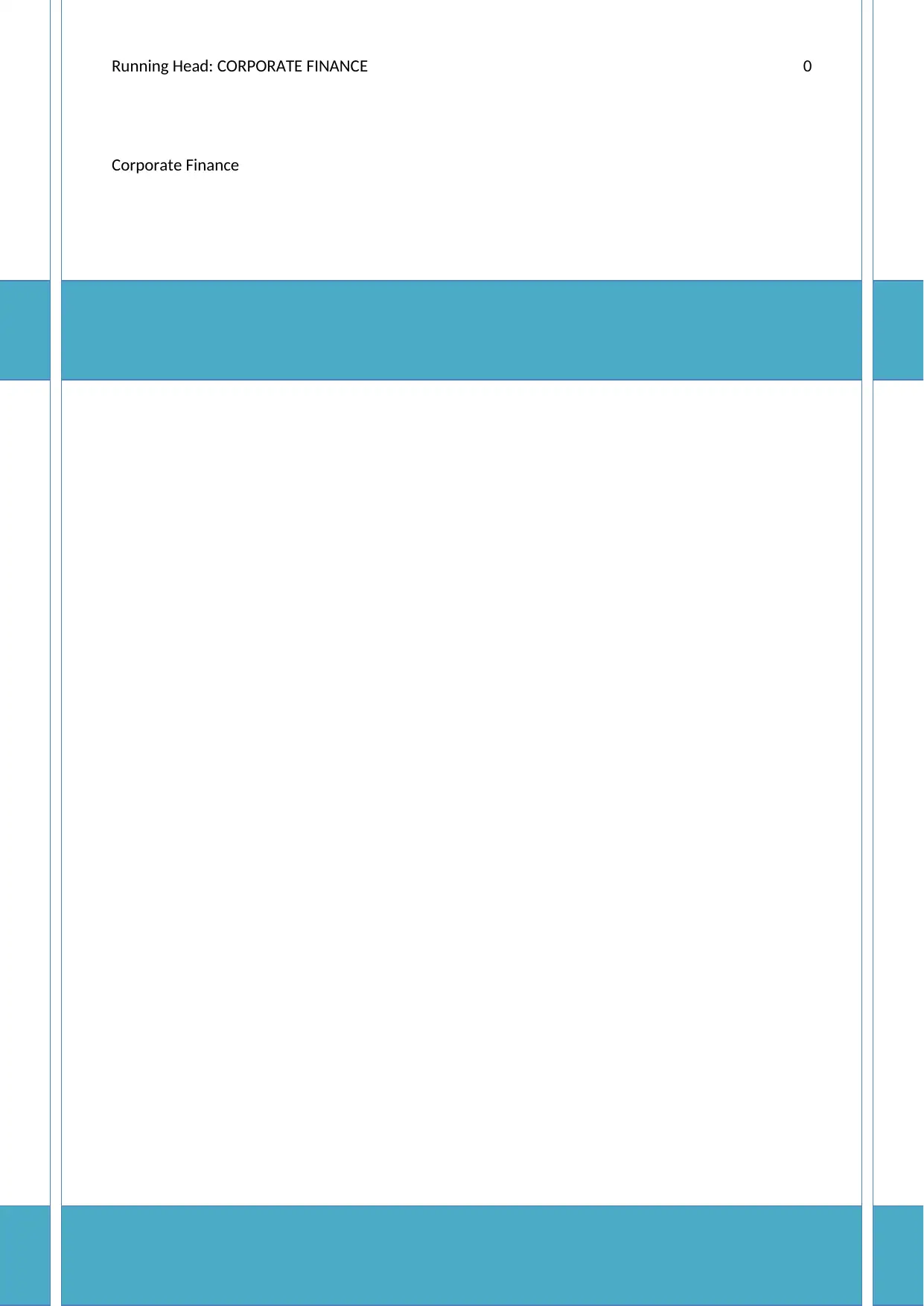
Running Head: CORPORATE FINANCE 0
Corporate Finance
Corporate Finance
Paraphrase This Document
Need a fresh take? Get an instant paraphrase of this document with our AI Paraphraser
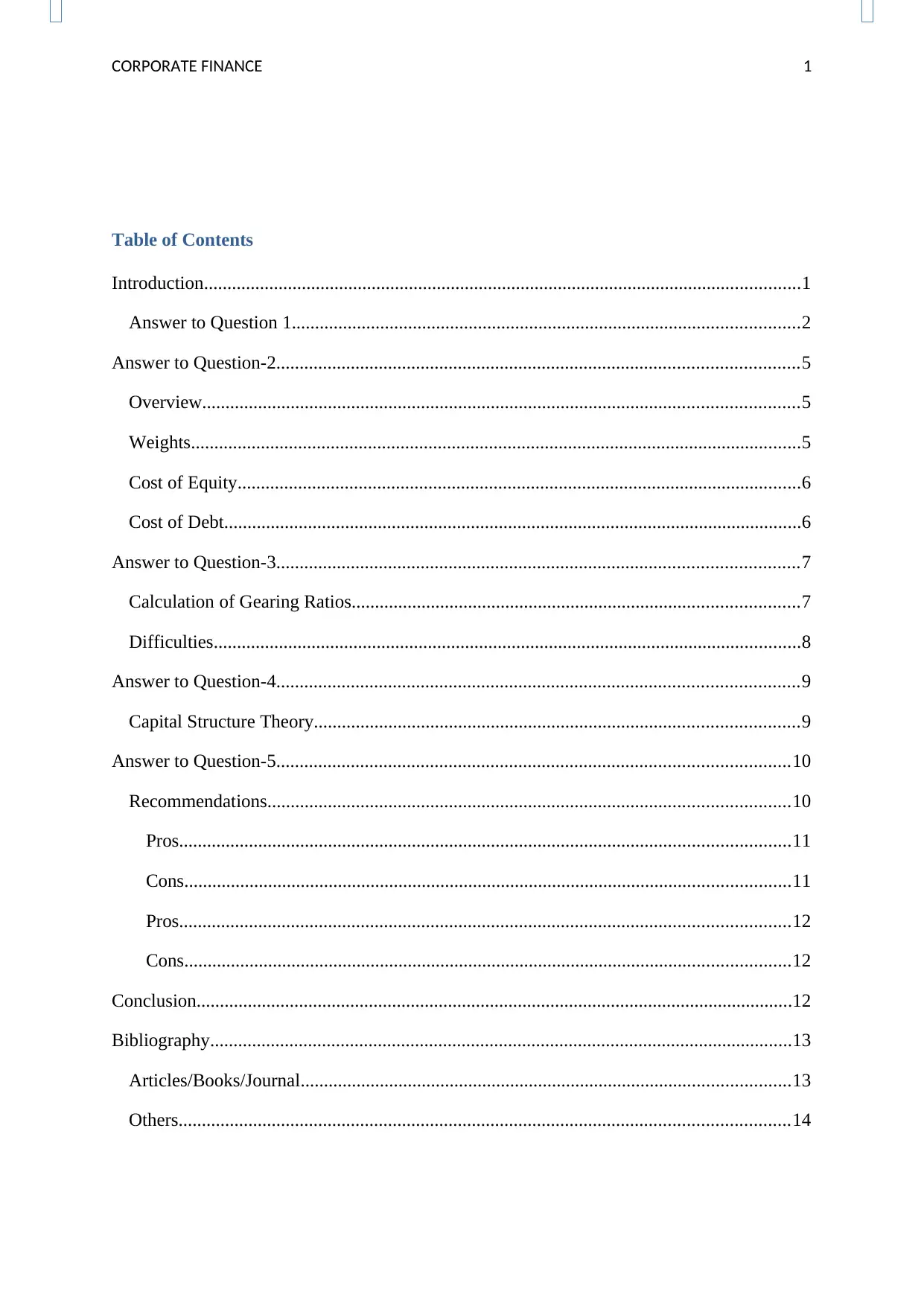
CORPORATE FINANCE 1
Table of Contents
Introduction................................................................................................................................1
Answer to Question 1.............................................................................................................2
Answer to Question-2................................................................................................................5
Overview................................................................................................................................5
Weights...................................................................................................................................5
Cost of Equity.........................................................................................................................6
Cost of Debt............................................................................................................................6
Answer to Question-3................................................................................................................7
Calculation of Gearing Ratios................................................................................................7
Difficulties..............................................................................................................................8
Answer to Question-4................................................................................................................9
Capital Structure Theory........................................................................................................9
Answer to Question-5..............................................................................................................10
Recommendations................................................................................................................10
Pros...................................................................................................................................11
Cons..................................................................................................................................11
Pros...................................................................................................................................12
Cons..................................................................................................................................12
Conclusion................................................................................................................................12
Bibliography.............................................................................................................................13
Articles/Books/Journal.........................................................................................................13
Others...................................................................................................................................14
Table of Contents
Introduction................................................................................................................................1
Answer to Question 1.............................................................................................................2
Answer to Question-2................................................................................................................5
Overview................................................................................................................................5
Weights...................................................................................................................................5
Cost of Equity.........................................................................................................................6
Cost of Debt............................................................................................................................6
Answer to Question-3................................................................................................................7
Calculation of Gearing Ratios................................................................................................7
Difficulties..............................................................................................................................8
Answer to Question-4................................................................................................................9
Capital Structure Theory........................................................................................................9
Answer to Question-5..............................................................................................................10
Recommendations................................................................................................................10
Pros...................................................................................................................................11
Cons..................................................................................................................................11
Pros...................................................................................................................................12
Cons..................................................................................................................................12
Conclusion................................................................................................................................12
Bibliography.............................................................................................................................13
Articles/Books/Journal.........................................................................................................13
Others...................................................................................................................................14
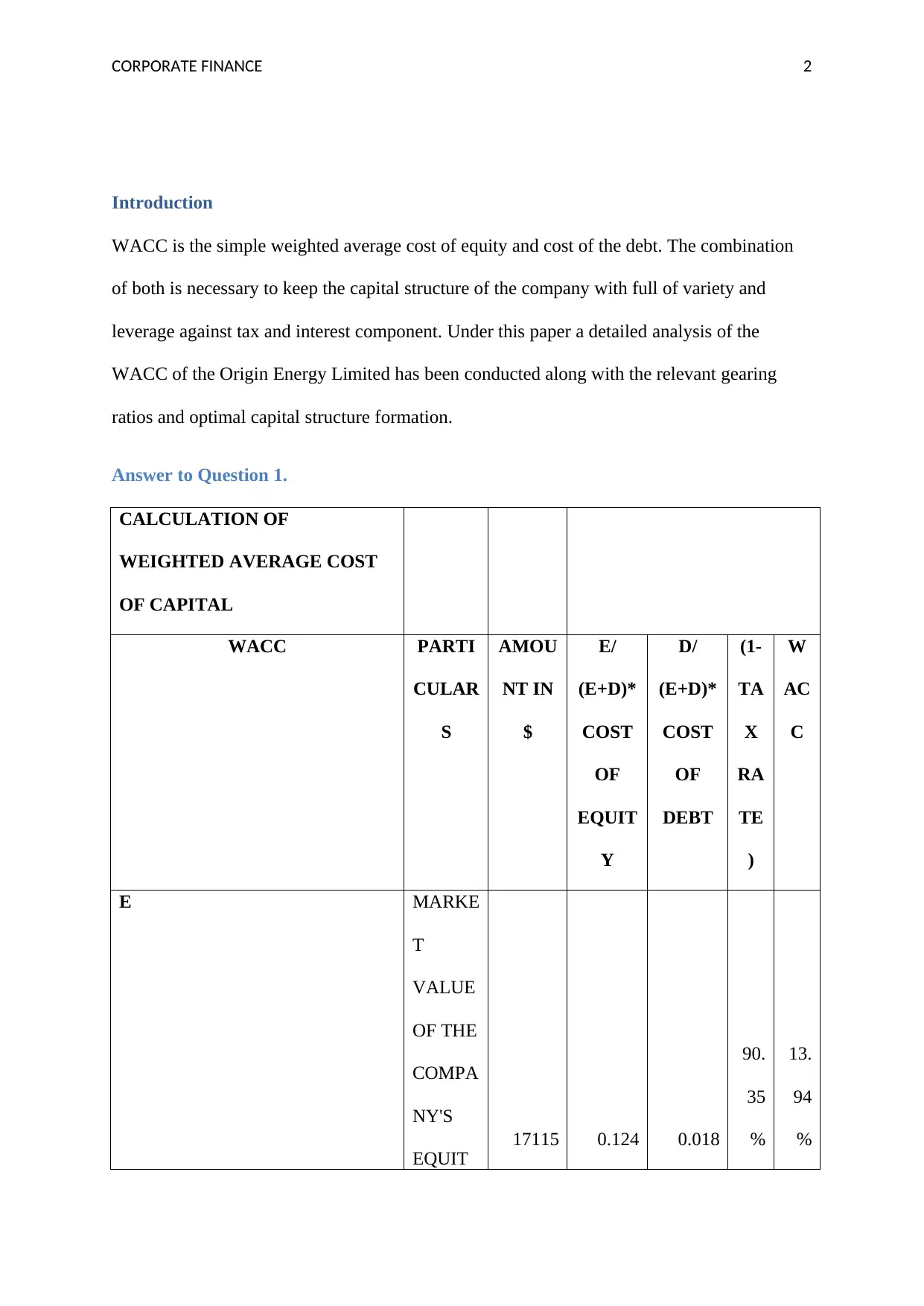
CORPORATE FINANCE 2
Introduction
WACC is the simple weighted average cost of equity and cost of the debt. The combination
of both is necessary to keep the capital structure of the company with full of variety and
leverage against tax and interest component. Under this paper a detailed analysis of the
WACC of the Origin Energy Limited has been conducted along with the relevant gearing
ratios and optimal capital structure formation.
Answer to Question 1.
CALCULATION OF
WEIGHTED AVERAGE COST
OF CAPITAL
WACC PARTI
CULAR
S
AMOU
NT IN
$
E/
(E+D)*
COST
OF
EQUIT
Y
D/
(E+D)*
COST
OF
DEBT
(1-
TA
X
RA
TE
)
W
AC
C
E MARKE
T
VALUE
OF THE
COMPA
NY'S
EQUIT
17115 0.124 0.018
90.
35
%
13.
94
%
Introduction
WACC is the simple weighted average cost of equity and cost of the debt. The combination
of both is necessary to keep the capital structure of the company with full of variety and
leverage against tax and interest component. Under this paper a detailed analysis of the
WACC of the Origin Energy Limited has been conducted along with the relevant gearing
ratios and optimal capital structure formation.
Answer to Question 1.
CALCULATION OF
WEIGHTED AVERAGE COST
OF CAPITAL
WACC PARTI
CULAR
S
AMOU
NT IN
$
E/
(E+D)*
COST
OF
EQUIT
Y
D/
(E+D)*
COST
OF
DEBT
(1-
TA
X
RA
TE
)
W
AC
C
E MARKE
T
VALUE
OF THE
COMPA
NY'S
EQUIT
17115 0.124 0.018
90.
35
%
13.
94
%
⊘ This is a preview!⊘
Do you want full access?
Subscribe today to unlock all pages.

Trusted by 1+ million students worldwide
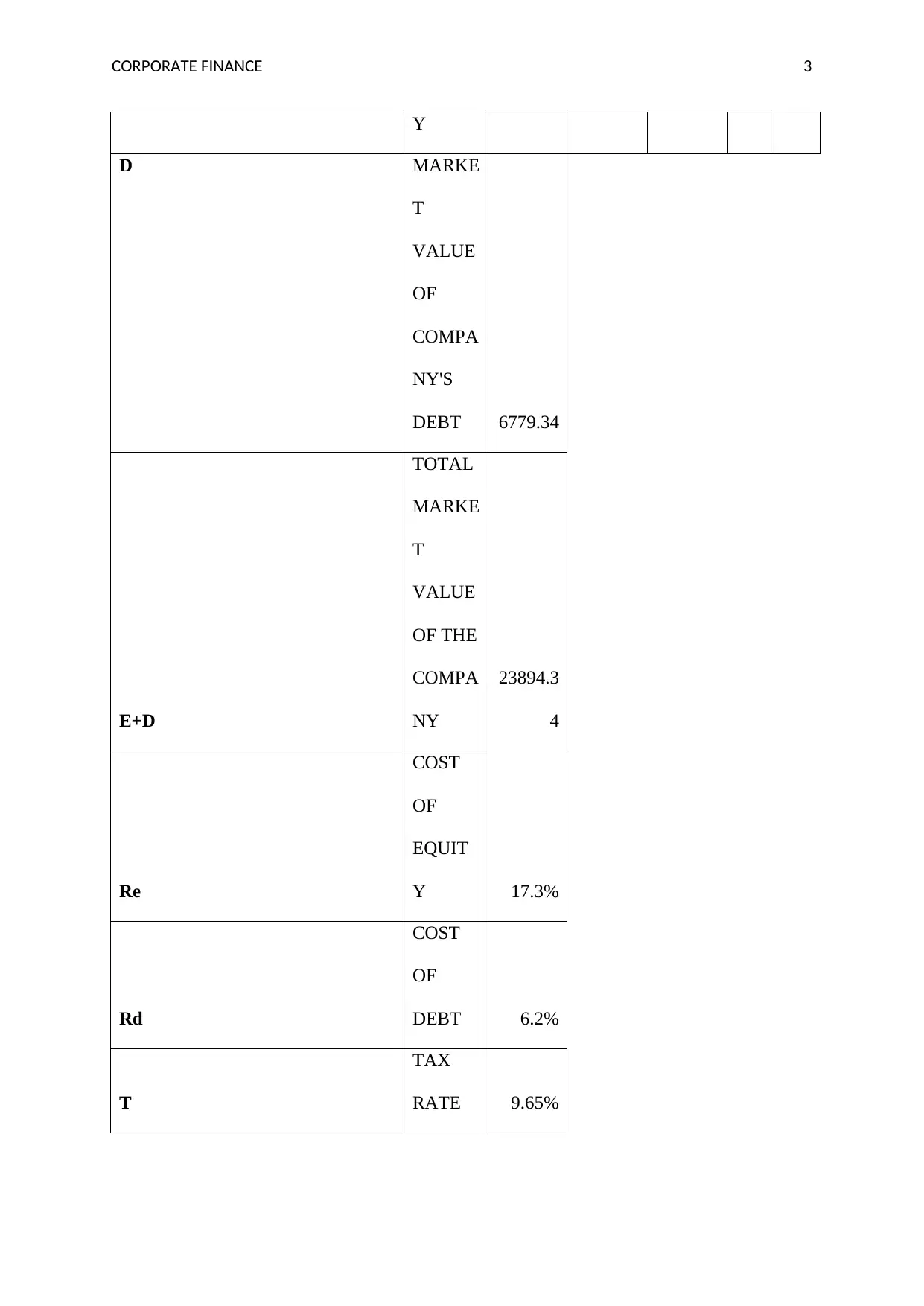
CORPORATE FINANCE 3
Y
D MARKE
T
VALUE
OF
COMPA
NY'S
DEBT 6779.34
E+D
TOTAL
MARKE
T
VALUE
OF THE
COMPA
NY
23894.3
4
Re
COST
OF
EQUIT
Y 17.3%
Rd
COST
OF
DEBT 6.2%
T
TAX
RATE 9.65%
Y
D MARKE
T
VALUE
OF
COMPA
NY'S
DEBT 6779.34
E+D
TOTAL
MARKE
T
VALUE
OF THE
COMPA
NY
23894.3
4
Re
COST
OF
EQUIT
Y 17.3%
Rd
COST
OF
DEBT 6.2%
T
TAX
RATE 9.65%
Paraphrase This Document
Need a fresh take? Get an instant paraphrase of this document with our AI Paraphraser
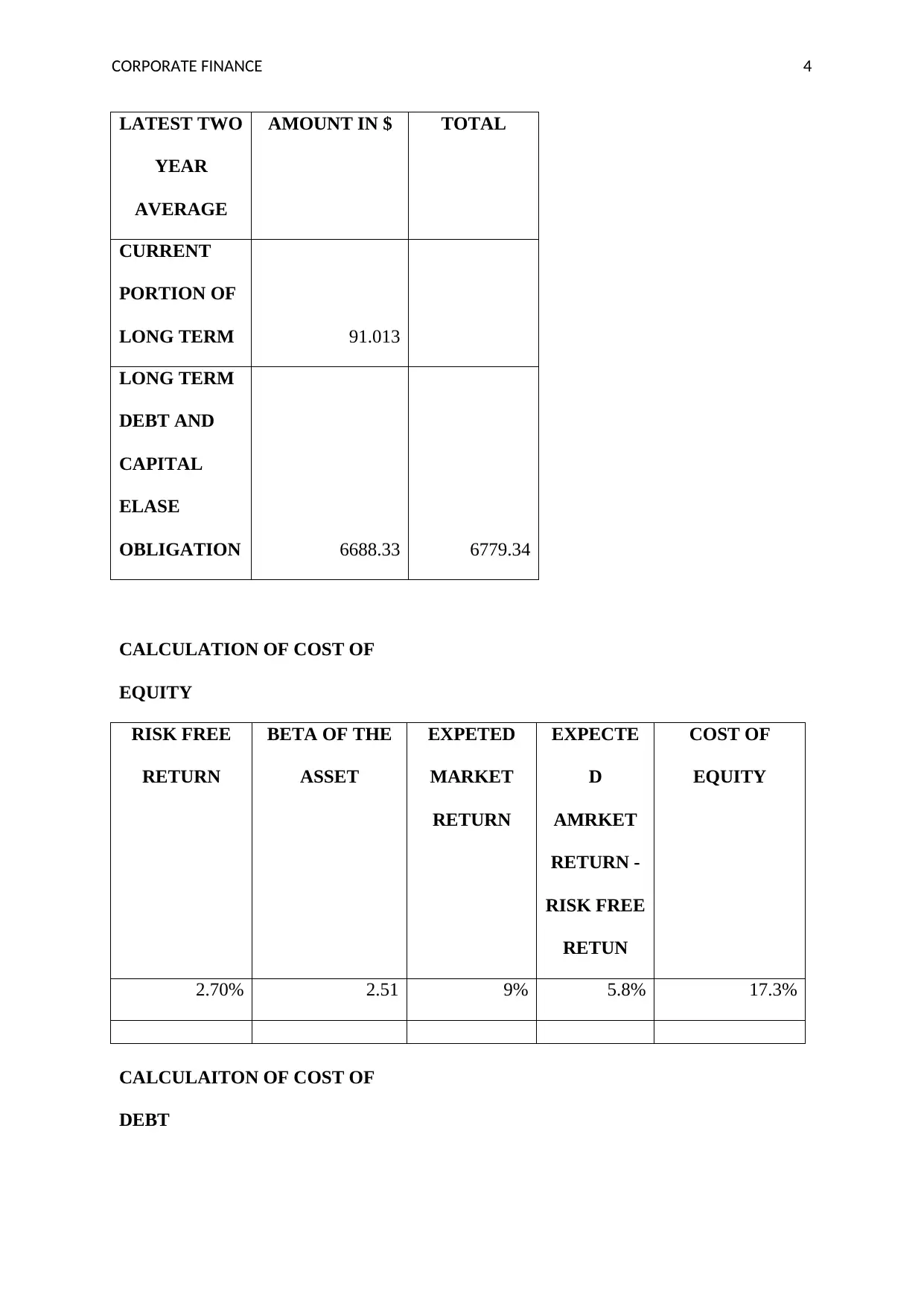
CORPORATE FINANCE 4
LATEST TWO
YEAR
AVERAGE
AMOUNT IN $ TOTAL
CURRENT
PORTION OF
LONG TERM 91.013
LONG TERM
DEBT AND
CAPITAL
ELASE
OBLIGATION 6688.33 6779.34
CALCULATION OF COST OF
EQUITY
RISK FREE
RETURN
BETA OF THE
ASSET
EXPETED
MARKET
RETURN
EXPECTE
D
AMRKET
RETURN -
RISK FREE
RETUN
COST OF
EQUITY
2.70% 2.51 9% 5.8% 17.3%
CALCULAITON OF COST OF
DEBT
LATEST TWO
YEAR
AVERAGE
AMOUNT IN $ TOTAL
CURRENT
PORTION OF
LONG TERM 91.013
LONG TERM
DEBT AND
CAPITAL
ELASE
OBLIGATION 6688.33 6779.34
CALCULATION OF COST OF
EQUITY
RISK FREE
RETURN
BETA OF THE
ASSET
EXPETED
MARKET
RETURN
EXPECTE
D
AMRKET
RETURN -
RISK FREE
RETUN
COST OF
EQUITY
2.70% 2.51 9% 5.8% 17.3%
CALCULAITON OF COST OF
DEBT
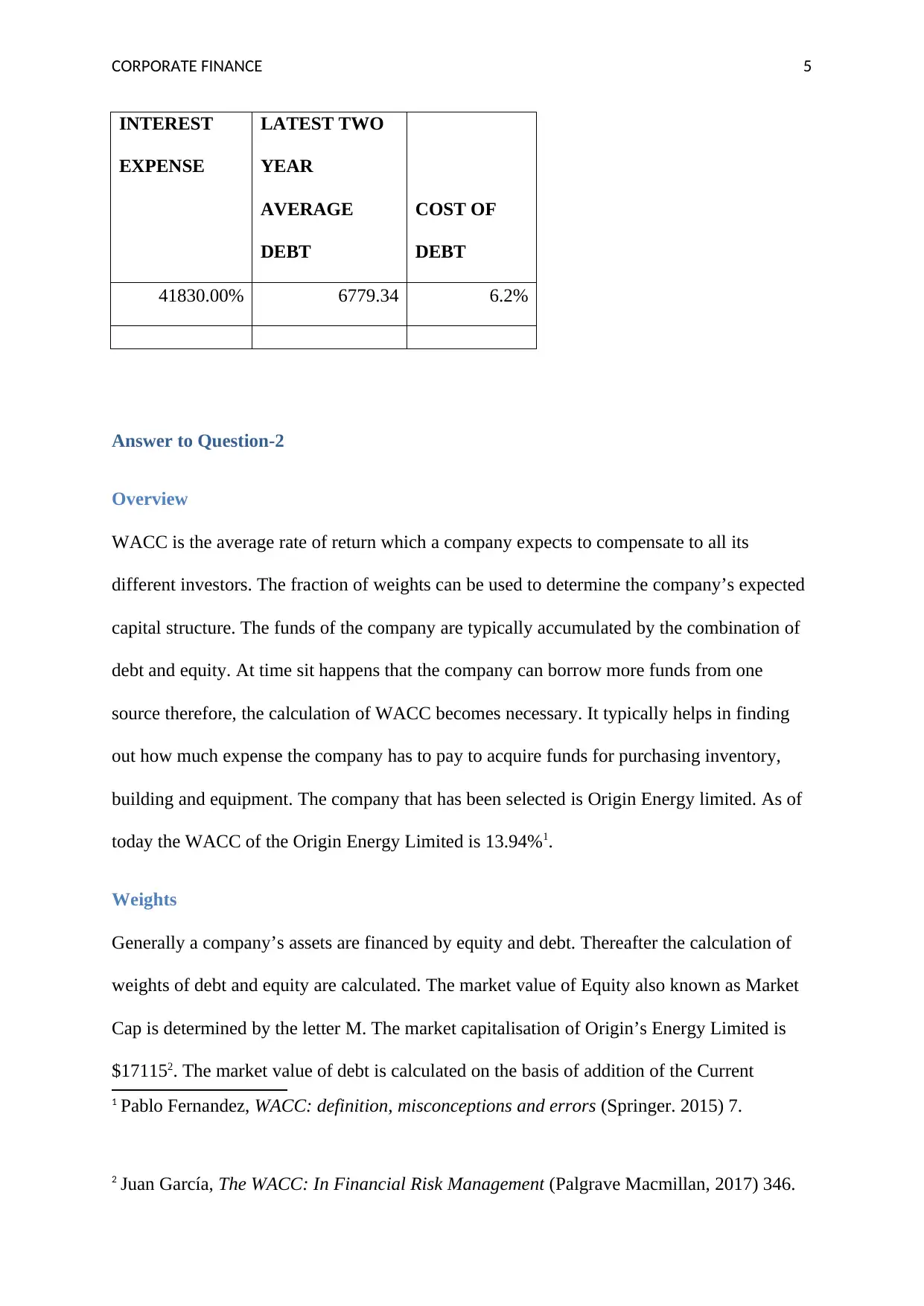
CORPORATE FINANCE 5
INTEREST
EXPENSE
LATEST TWO
YEAR
AVERAGE
DEBT
COST OF
DEBT
41830.00% 6779.34 6.2%
Answer to Question-2
Overview
WACC is the average rate of return which a company expects to compensate to all its
different investors. The fraction of weights can be used to determine the company’s expected
capital structure. The funds of the company are typically accumulated by the combination of
debt and equity. At time sit happens that the company can borrow more funds from one
source therefore, the calculation of WACC becomes necessary. It typically helps in finding
out how much expense the company has to pay to acquire funds for purchasing inventory,
building and equipment. The company that has been selected is Origin Energy limited. As of
today the WACC of the Origin Energy Limited is 13.94%1.
Weights
Generally a company’s assets are financed by equity and debt. Thereafter the calculation of
weights of debt and equity are calculated. The market value of Equity also known as Market
Cap is determined by the letter M. The market capitalisation of Origin’s Energy Limited is
$171152. The market value of debt is calculated on the basis of addition of the Current
1 Pablo Fernandez, WACC: definition, misconceptions and errors (Springer. 2015) 7.
2 Juan García, The WACC: In Financial Risk Management (Palgrave Macmillan, 2017) 346.
INTEREST
EXPENSE
LATEST TWO
YEAR
AVERAGE
DEBT
COST OF
DEBT
41830.00% 6779.34 6.2%
Answer to Question-2
Overview
WACC is the average rate of return which a company expects to compensate to all its
different investors. The fraction of weights can be used to determine the company’s expected
capital structure. The funds of the company are typically accumulated by the combination of
debt and equity. At time sit happens that the company can borrow more funds from one
source therefore, the calculation of WACC becomes necessary. It typically helps in finding
out how much expense the company has to pay to acquire funds for purchasing inventory,
building and equipment. The company that has been selected is Origin Energy limited. As of
today the WACC of the Origin Energy Limited is 13.94%1.
Weights
Generally a company’s assets are financed by equity and debt. Thereafter the calculation of
weights of debt and equity are calculated. The market value of Equity also known as Market
Cap is determined by the letter M. The market capitalisation of Origin’s Energy Limited is
$171152. The market value of debt is calculated on the basis of addition of the Current
1 Pablo Fernandez, WACC: definition, misconceptions and errors (Springer. 2015) 7.
2 Juan García, The WACC: In Financial Risk Management (Palgrave Macmillan, 2017) 346.
⊘ This is a preview!⊘
Do you want full access?
Subscribe today to unlock all pages.

Trusted by 1+ million students worldwide
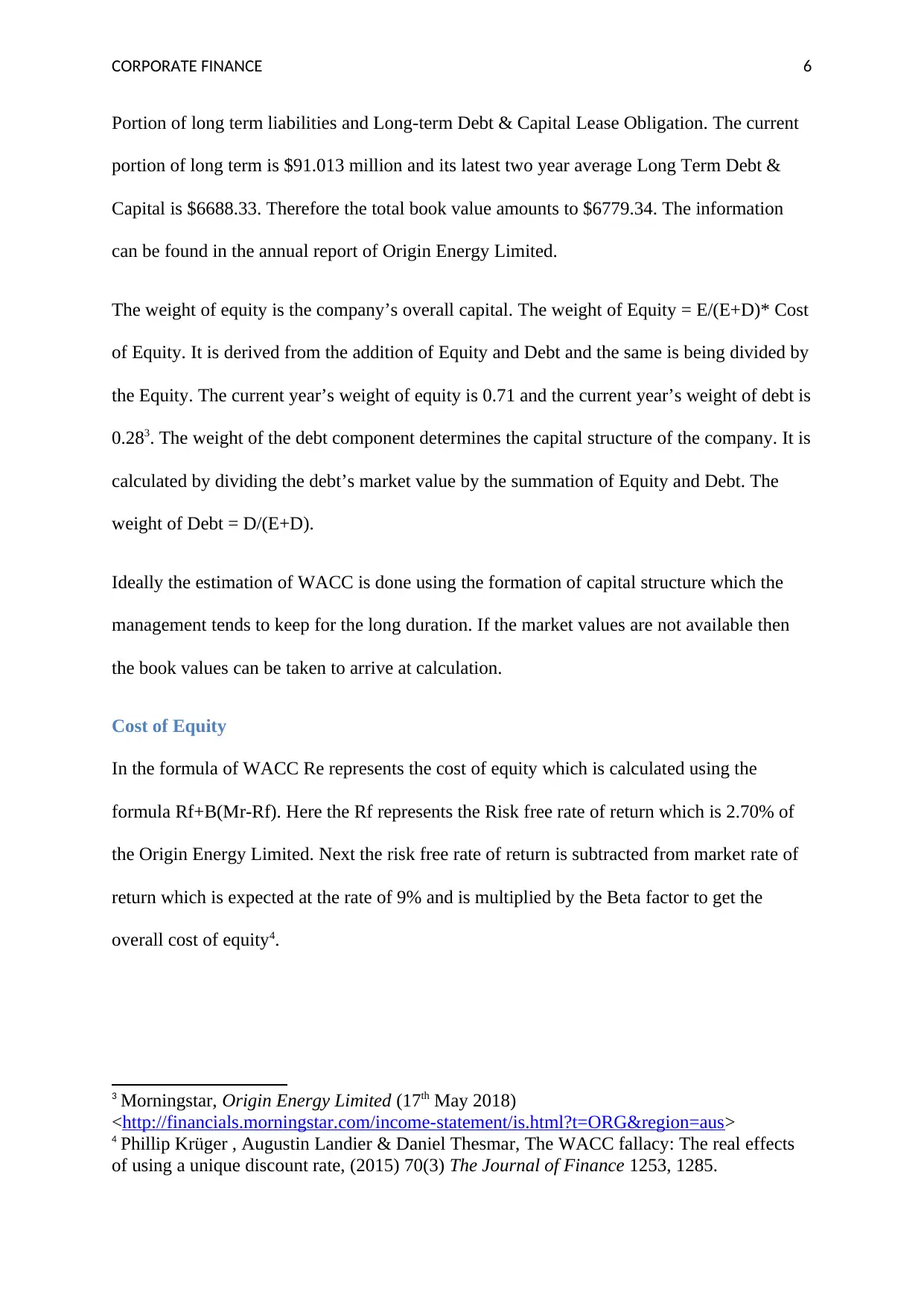
CORPORATE FINANCE 6
Portion of long term liabilities and Long-term Debt & Capital Lease Obligation. The current
portion of long term is $91.013 million and its latest two year average Long Term Debt &
Capital is $6688.33. Therefore the total book value amounts to $6779.34. The information
can be found in the annual report of Origin Energy Limited.
The weight of equity is the company’s overall capital. The weight of Equity = E/(E+D)* Cost
of Equity. It is derived from the addition of Equity and Debt and the same is being divided by
the Equity. The current year’s weight of equity is 0.71 and the current year’s weight of debt is
0.283. The weight of the debt component determines the capital structure of the company. It is
calculated by dividing the debt’s market value by the summation of Equity and Debt. The
weight of Debt = D/(E+D).
Ideally the estimation of WACC is done using the formation of capital structure which the
management tends to keep for the long duration. If the market values are not available then
the book values can be taken to arrive at calculation.
Cost of Equity
In the formula of WACC Re represents the cost of equity which is calculated using the
formula Rf+B(Mr-Rf). Here the Rf represents the Risk free rate of return which is 2.70% of
the Origin Energy Limited. Next the risk free rate of return is subtracted from market rate of
return which is expected at the rate of 9% and is multiplied by the Beta factor to get the
overall cost of equity4.
3 Morningstar, Origin Energy Limited (17th May 2018)
<http://financials.morningstar.com/income-statement/is.html?t=ORG®ion=aus>
4 Phillip Krüger , Augustin Landier & Daniel Thesmar, The WACC fallacy: The real effects
of using a unique discount rate, (2015) 70(3) The Journal of Finance 1253, 1285.
Portion of long term liabilities and Long-term Debt & Capital Lease Obligation. The current
portion of long term is $91.013 million and its latest two year average Long Term Debt &
Capital is $6688.33. Therefore the total book value amounts to $6779.34. The information
can be found in the annual report of Origin Energy Limited.
The weight of equity is the company’s overall capital. The weight of Equity = E/(E+D)* Cost
of Equity. It is derived from the addition of Equity and Debt and the same is being divided by
the Equity. The current year’s weight of equity is 0.71 and the current year’s weight of debt is
0.283. The weight of the debt component determines the capital structure of the company. It is
calculated by dividing the debt’s market value by the summation of Equity and Debt. The
weight of Debt = D/(E+D).
Ideally the estimation of WACC is done using the formation of capital structure which the
management tends to keep for the long duration. If the market values are not available then
the book values can be taken to arrive at calculation.
Cost of Equity
In the formula of WACC Re represents the cost of equity which is calculated using the
formula Rf+B(Mr-Rf). Here the Rf represents the Risk free rate of return which is 2.70% of
the Origin Energy Limited. Next the risk free rate of return is subtracted from market rate of
return which is expected at the rate of 9% and is multiplied by the Beta factor to get the
overall cost of equity4.
3 Morningstar, Origin Energy Limited (17th May 2018)
<http://financials.morningstar.com/income-statement/is.html?t=ORG®ion=aus>
4 Phillip Krüger , Augustin Landier & Daniel Thesmar, The WACC fallacy: The real effects
of using a unique discount rate, (2015) 70(3) The Journal of Finance 1253, 1285.
Paraphrase This Document
Need a fresh take? Get an instant paraphrase of this document with our AI Paraphraser
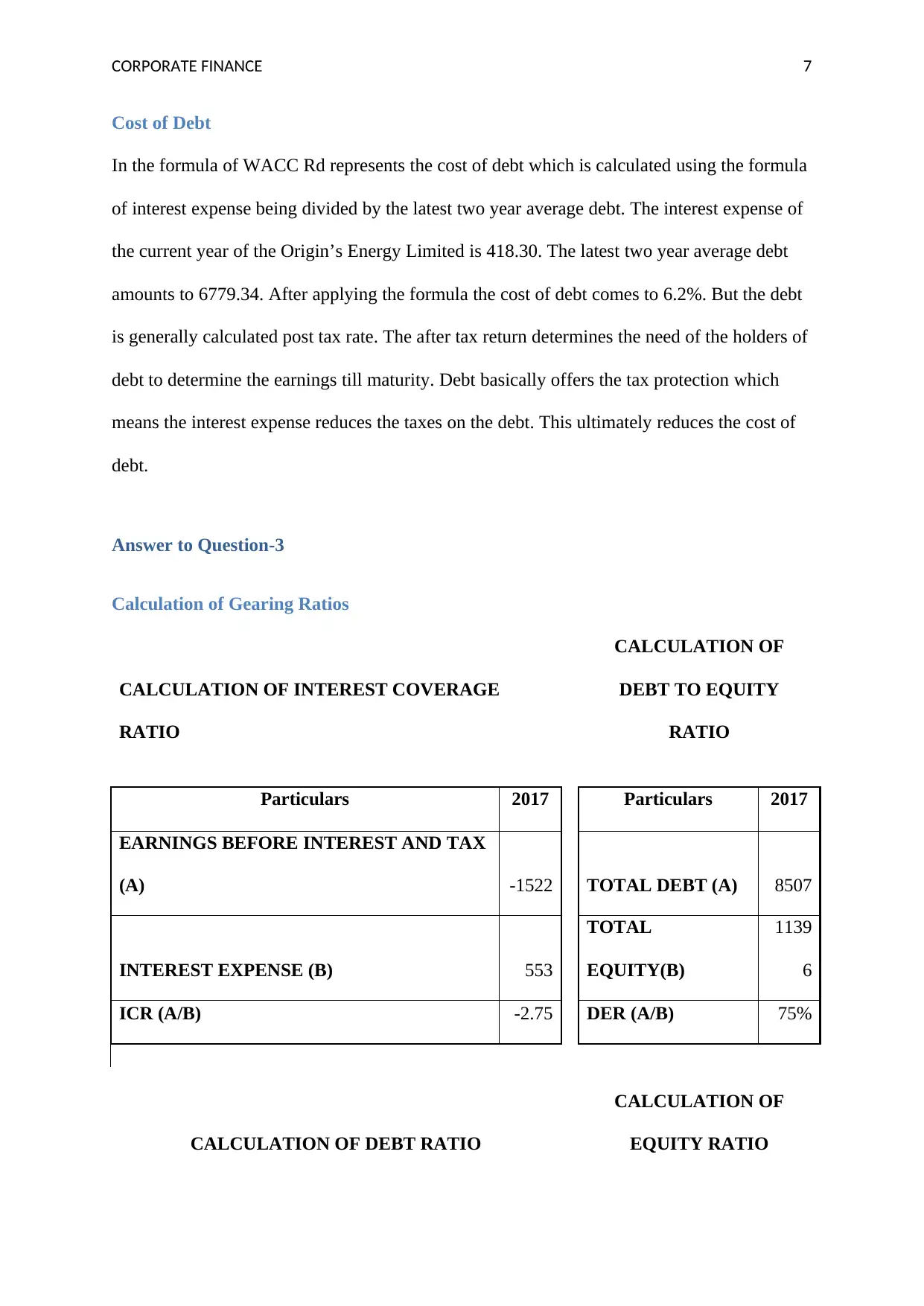
CORPORATE FINANCE 7
Cost of Debt
In the formula of WACC Rd represents the cost of debt which is calculated using the formula
of interest expense being divided by the latest two year average debt. The interest expense of
the current year of the Origin’s Energy Limited is 418.30. The latest two year average debt
amounts to 6779.34. After applying the formula the cost of debt comes to 6.2%. But the debt
is generally calculated post tax rate. The after tax return determines the need of the holders of
debt to determine the earnings till maturity. Debt basically offers the tax protection which
means the interest expense reduces the taxes on the debt. This ultimately reduces the cost of
debt.
Answer to Question-3
Calculation of Gearing Ratios
CALCULATION OF INTEREST COVERAGE
RATIO
CALCULATION OF
DEBT TO EQUITY
RATIO
Particulars 2017 Particulars 2017
EARNINGS BEFORE INTEREST AND TAX
(A) -1522 TOTAL DEBT (A) 8507
INTEREST EXPENSE (B) 553
TOTAL
EQUITY(B)
1139
6
ICR (A/B) -2.75 DER (A/B) 75%
CALCULATION OF DEBT RATIO
CALCULATION OF
EQUITY RATIO
Cost of Debt
In the formula of WACC Rd represents the cost of debt which is calculated using the formula
of interest expense being divided by the latest two year average debt. The interest expense of
the current year of the Origin’s Energy Limited is 418.30. The latest two year average debt
amounts to 6779.34. After applying the formula the cost of debt comes to 6.2%. But the debt
is generally calculated post tax rate. The after tax return determines the need of the holders of
debt to determine the earnings till maturity. Debt basically offers the tax protection which
means the interest expense reduces the taxes on the debt. This ultimately reduces the cost of
debt.
Answer to Question-3
Calculation of Gearing Ratios
CALCULATION OF INTEREST COVERAGE
RATIO
CALCULATION OF
DEBT TO EQUITY
RATIO
Particulars 2017 Particulars 2017
EARNINGS BEFORE INTEREST AND TAX
(A) -1522 TOTAL DEBT (A) 8507
INTEREST EXPENSE (B) 553
TOTAL
EQUITY(B)
1139
6
ICR (A/B) -2.75 DER (A/B) 75%
CALCULATION OF DEBT RATIO
CALCULATION OF
EQUITY RATIO
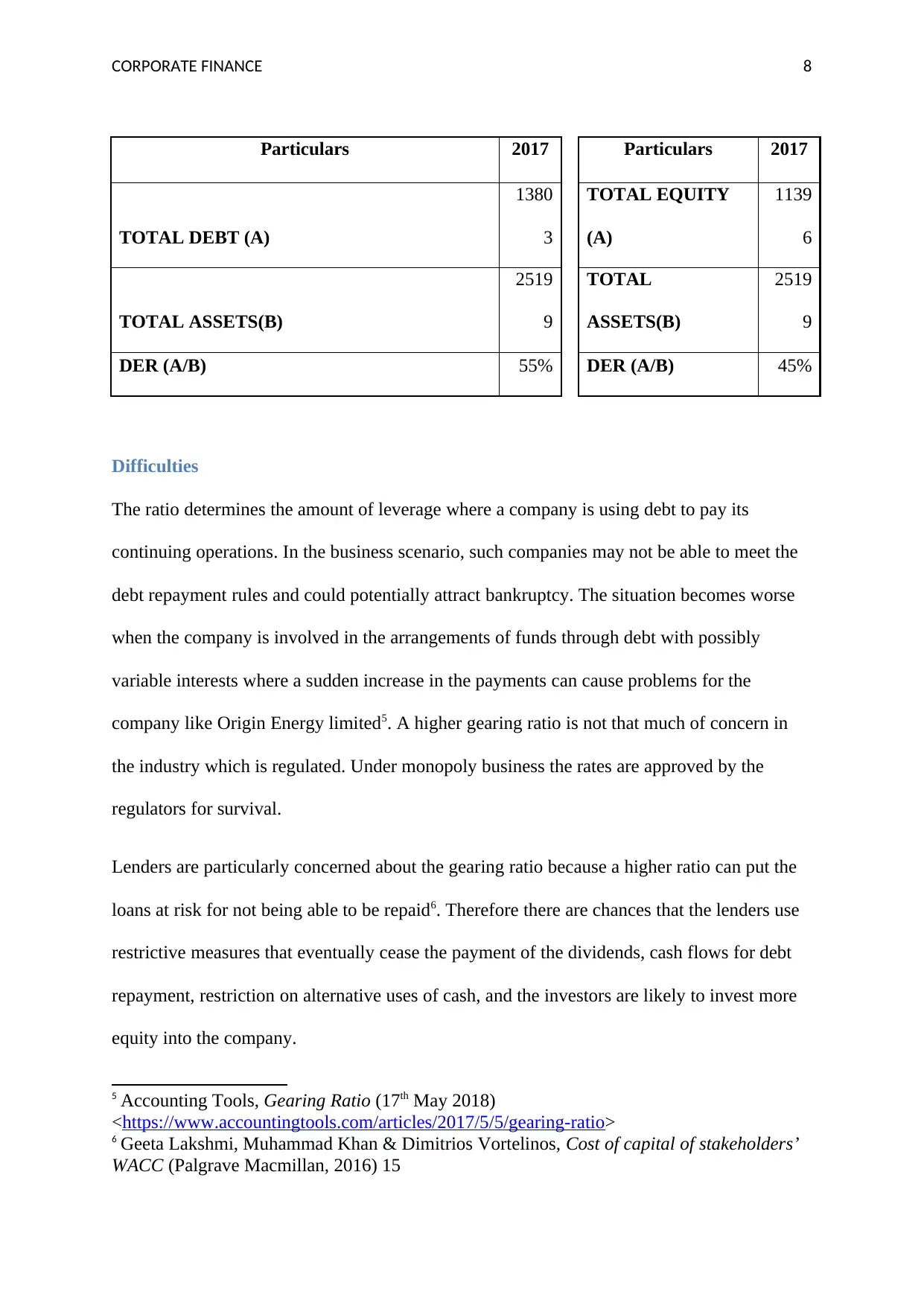
CORPORATE FINANCE 8
Particulars 2017 Particulars 2017
TOTAL DEBT (A)
1380
3
TOTAL EQUITY
(A)
1139
6
TOTAL ASSETS(B)
2519
9
TOTAL
ASSETS(B)
2519
9
DER (A/B) 55% DER (A/B) 45%
Difficulties
The ratio determines the amount of leverage where a company is using debt to pay its
continuing operations. In the business scenario, such companies may not be able to meet the
debt repayment rules and could potentially attract bankruptcy. The situation becomes worse
when the company is involved in the arrangements of funds through debt with possibly
variable interests where a sudden increase in the payments can cause problems for the
company like Origin Energy limited5. A higher gearing ratio is not that much of concern in
the industry which is regulated. Under monopoly business the rates are approved by the
regulators for survival.
Lenders are particularly concerned about the gearing ratio because a higher ratio can put the
loans at risk for not being able to be repaid6. Therefore there are chances that the lenders use
restrictive measures that eventually cease the payment of the dividends, cash flows for debt
repayment, restriction on alternative uses of cash, and the investors are likely to invest more
equity into the company.
5 Accounting Tools, Gearing Ratio (17th May 2018)
<https://www.accountingtools.com/articles/2017/5/5/gearing-ratio>
6 Geeta Lakshmi, Muhammad Khan & Dimitrios Vortelinos, Cost of capital of stakeholders’
WACC (Palgrave Macmillan, 2016) 15
Particulars 2017 Particulars 2017
TOTAL DEBT (A)
1380
3
TOTAL EQUITY
(A)
1139
6
TOTAL ASSETS(B)
2519
9
TOTAL
ASSETS(B)
2519
9
DER (A/B) 55% DER (A/B) 45%
Difficulties
The ratio determines the amount of leverage where a company is using debt to pay its
continuing operations. In the business scenario, such companies may not be able to meet the
debt repayment rules and could potentially attract bankruptcy. The situation becomes worse
when the company is involved in the arrangements of funds through debt with possibly
variable interests where a sudden increase in the payments can cause problems for the
company like Origin Energy limited5. A higher gearing ratio is not that much of concern in
the industry which is regulated. Under monopoly business the rates are approved by the
regulators for survival.
Lenders are particularly concerned about the gearing ratio because a higher ratio can put the
loans at risk for not being able to be repaid6. Therefore there are chances that the lenders use
restrictive measures that eventually cease the payment of the dividends, cash flows for debt
repayment, restriction on alternative uses of cash, and the investors are likely to invest more
equity into the company.
5 Accounting Tools, Gearing Ratio (17th May 2018)
<https://www.accountingtools.com/articles/2017/5/5/gearing-ratio>
6 Geeta Lakshmi, Muhammad Khan & Dimitrios Vortelinos, Cost of capital of stakeholders’
WACC (Palgrave Macmillan, 2016) 15
⊘ This is a preview!⊘
Do you want full access?
Subscribe today to unlock all pages.

Trusted by 1+ million students worldwide
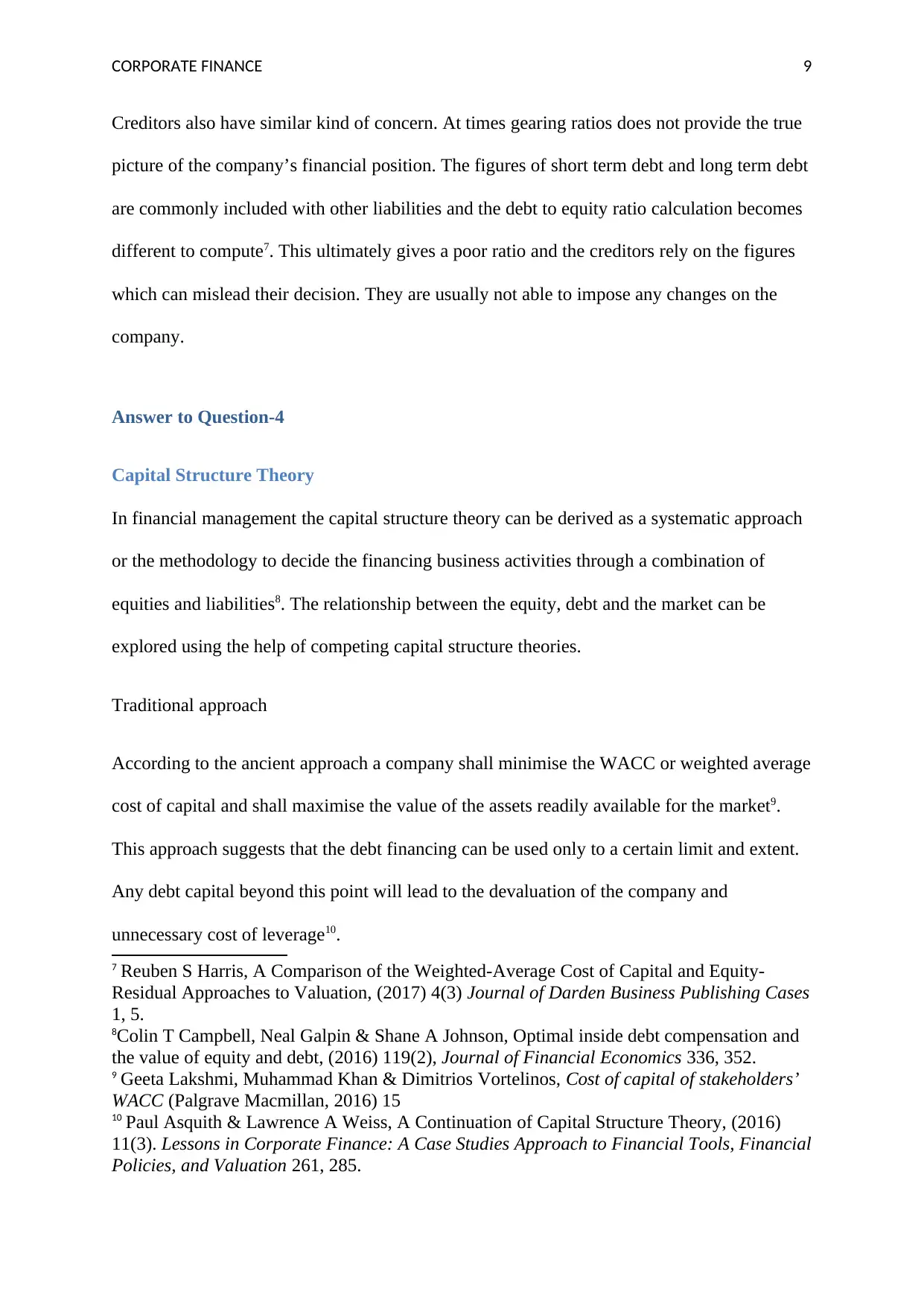
CORPORATE FINANCE 9
Creditors also have similar kind of concern. At times gearing ratios does not provide the true
picture of the company’s financial position. The figures of short term debt and long term debt
are commonly included with other liabilities and the debt to equity ratio calculation becomes
different to compute7. This ultimately gives a poor ratio and the creditors rely on the figures
which can mislead their decision. They are usually not able to impose any changes on the
company.
Answer to Question-4
Capital Structure Theory
In financial management the capital structure theory can be derived as a systematic approach
or the methodology to decide the financing business activities through a combination of
equities and liabilities8. The relationship between the equity, debt and the market can be
explored using the help of competing capital structure theories.
Traditional approach
According to the ancient approach a company shall minimise the WACC or weighted average
cost of capital and shall maximise the value of the assets readily available for the market9.
This approach suggests that the debt financing can be used only to a certain limit and extent.
Any debt capital beyond this point will lead to the devaluation of the company and
unnecessary cost of leverage10.
7 Reuben S Harris, A Comparison of the Weighted-Average Cost of Capital and Equity-
Residual Approaches to Valuation, (2017) 4(3) Journal of Darden Business Publishing Cases
1, 5.
8Colin T Campbell, Neal Galpin & Shane A Johnson, Optimal inside debt compensation and
the value of equity and debt, (2016) 119(2), Journal of Financial Economics 336, 352.
9 Geeta Lakshmi, Muhammad Khan & Dimitrios Vortelinos, Cost of capital of stakeholders’
WACC (Palgrave Macmillan, 2016) 15
10 Paul Asquith & Lawrence A Weiss, A Continuation of Capital Structure Theory, (2016)
11(3). Lessons in Corporate Finance: A Case Studies Approach to Financial Tools, Financial
Policies, and Valuation 261, 285.
Creditors also have similar kind of concern. At times gearing ratios does not provide the true
picture of the company’s financial position. The figures of short term debt and long term debt
are commonly included with other liabilities and the debt to equity ratio calculation becomes
different to compute7. This ultimately gives a poor ratio and the creditors rely on the figures
which can mislead their decision. They are usually not able to impose any changes on the
company.
Answer to Question-4
Capital Structure Theory
In financial management the capital structure theory can be derived as a systematic approach
or the methodology to decide the financing business activities through a combination of
equities and liabilities8. The relationship between the equity, debt and the market can be
explored using the help of competing capital structure theories.
Traditional approach
According to the ancient approach a company shall minimise the WACC or weighted average
cost of capital and shall maximise the value of the assets readily available for the market9.
This approach suggests that the debt financing can be used only to a certain limit and extent.
Any debt capital beyond this point will lead to the devaluation of the company and
unnecessary cost of leverage10.
7 Reuben S Harris, A Comparison of the Weighted-Average Cost of Capital and Equity-
Residual Approaches to Valuation, (2017) 4(3) Journal of Darden Business Publishing Cases
1, 5.
8Colin T Campbell, Neal Galpin & Shane A Johnson, Optimal inside debt compensation and
the value of equity and debt, (2016) 119(2), Journal of Financial Economics 336, 352.
9 Geeta Lakshmi, Muhammad Khan & Dimitrios Vortelinos, Cost of capital of stakeholders’
WACC (Palgrave Macmillan, 2016) 15
10 Paul Asquith & Lawrence A Weiss, A Continuation of Capital Structure Theory, (2016)
11(3). Lessons in Corporate Finance: A Case Studies Approach to Financial Tools, Financial
Policies, and Valuation 261, 285.
Paraphrase This Document
Need a fresh take? Get an instant paraphrase of this document with our AI Paraphraser

CORPORATE FINANCE 10
Under this theory the managers and the financial analysts are required to make certain
assumptions. For example the debt has an interest portion which remains constant during one
period and eventually increases when the leverage is additionally increased over the time.
The equity’s expected rate of return is also constant before the leverage of the company
increases gradually11. This creates an optimal point for the WACC to be small.
The financing decision has a direct impact on the WACC of the company. It is important to
note that the lower the WACC of the company the higher the market value will be of the
company. From the above calculations it can be observed that the WACC of the Origin
Energy Limited is 13.94%. The market value of the company increases when the WACC of
the company decreases. The relationship is of inverse nature. Therefore, the search for the
optimal capital structure of the company becomes the important factor. It is the responsibility
of the financial managers of the Origin Energy Limited to find the optimal capital structure
that will result in the lowest WACC.
As WACC is simply an average between the cost of debt and cost of equity, it becomes
necessary to determine which component is cheaper. The cost of debt is cheaper as compared
to the cost of equity. Debt is a component which carries less risk, the required return which is
need to be given to the investors is also less against the equity investors. The payment of
interest received by the debt holders is an amount of fixed nature and it is paid in priority
over the payment of the cumulative dividends. Another reason for the debt component to
carry less risk is derived at the time of liquidation of the company. Debt holders at the time of
liquidation will receive the payments before the shareholders12.
11 Edwin O Fischer, Robert Heinkel & Joseph Zechner, Dynamic capital structure choice:
Theory and tests, (2014) 44(1), The Journal of Finance, 19, 40.
12 Emanuel Camilleri and Roxanne Camilleri, Accounting for Financial Instruments: A Guide
to Valuation and Risk Management (Taylor & Francis, 2017) 10.
Under this theory the managers and the financial analysts are required to make certain
assumptions. For example the debt has an interest portion which remains constant during one
period and eventually increases when the leverage is additionally increased over the time.
The equity’s expected rate of return is also constant before the leverage of the company
increases gradually11. This creates an optimal point for the WACC to be small.
The financing decision has a direct impact on the WACC of the company. It is important to
note that the lower the WACC of the company the higher the market value will be of the
company. From the above calculations it can be observed that the WACC of the Origin
Energy Limited is 13.94%. The market value of the company increases when the WACC of
the company decreases. The relationship is of inverse nature. Therefore, the search for the
optimal capital structure of the company becomes the important factor. It is the responsibility
of the financial managers of the Origin Energy Limited to find the optimal capital structure
that will result in the lowest WACC.
As WACC is simply an average between the cost of debt and cost of equity, it becomes
necessary to determine which component is cheaper. The cost of debt is cheaper as compared
to the cost of equity. Debt is a component which carries less risk, the required return which is
need to be given to the investors is also less against the equity investors. The payment of
interest received by the debt holders is an amount of fixed nature and it is paid in priority
over the payment of the cumulative dividends. Another reason for the debt component to
carry less risk is derived at the time of liquidation of the company. Debt holders at the time of
liquidation will receive the payments before the shareholders12.
11 Edwin O Fischer, Robert Heinkel & Joseph Zechner, Dynamic capital structure choice:
Theory and tests, (2014) 44(1), The Journal of Finance, 19, 40.
12 Emanuel Camilleri and Roxanne Camilleri, Accounting for Financial Instruments: A Guide
to Valuation and Risk Management (Taylor & Francis, 2017) 10.
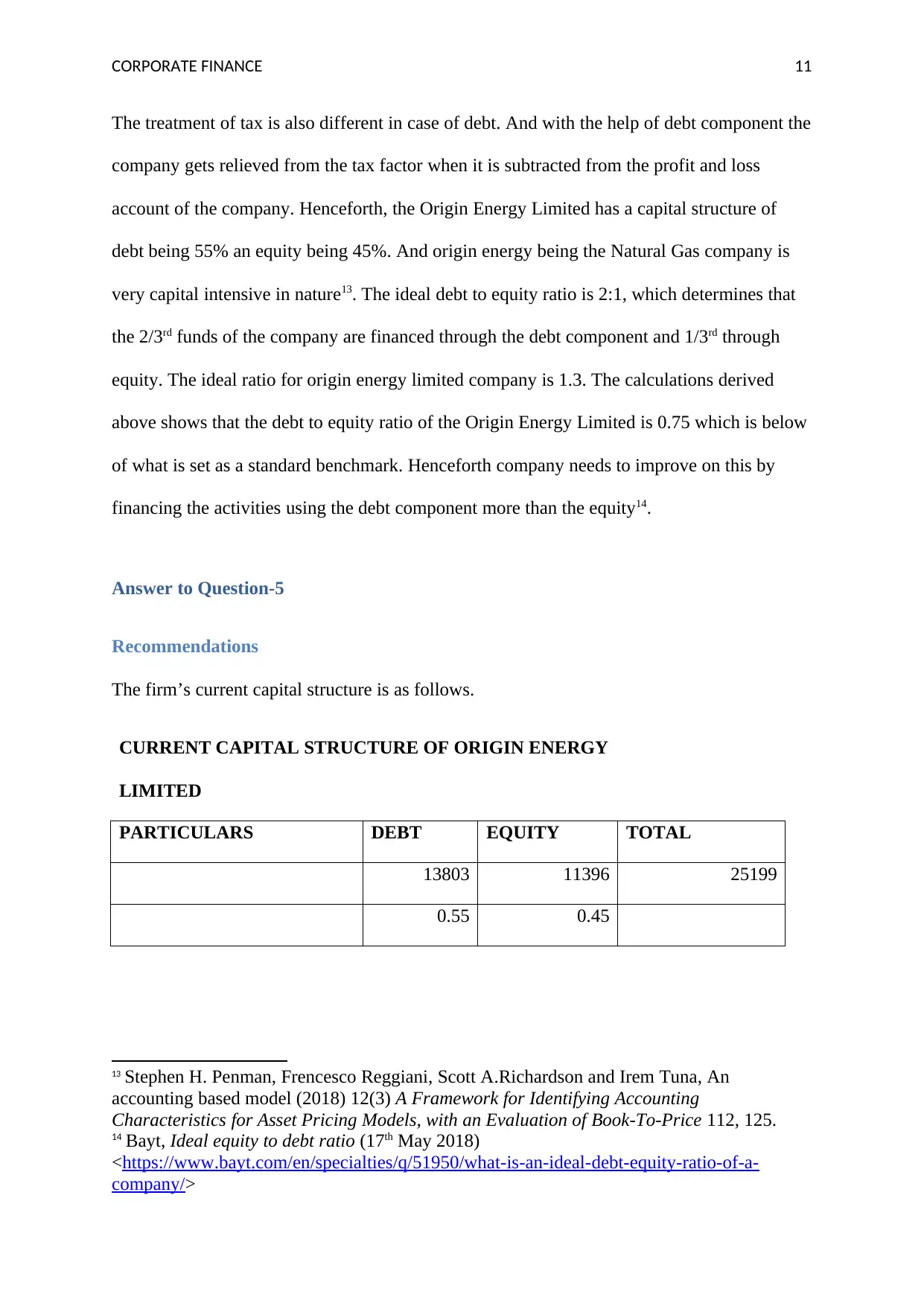
CORPORATE FINANCE 11
The treatment of tax is also different in case of debt. And with the help of debt component the
company gets relieved from the tax factor when it is subtracted from the profit and loss
account of the company. Henceforth, the Origin Energy Limited has a capital structure of
debt being 55% an equity being 45%. And origin energy being the Natural Gas company is
very capital intensive in nature13. The ideal debt to equity ratio is 2:1, which determines that
the 2/3rd funds of the company are financed through the debt component and 1/3rd through
equity. The ideal ratio for origin energy limited company is 1.3. The calculations derived
above shows that the debt to equity ratio of the Origin Energy Limited is 0.75 which is below
of what is set as a standard benchmark. Henceforth company needs to improve on this by
financing the activities using the debt component more than the equity14.
Answer to Question-5
Recommendations
The firm’s current capital structure is as follows.
CURRENT CAPITAL STRUCTURE OF ORIGIN ENERGY
LIMITED
PARTICULARS DEBT EQUITY TOTAL
13803 11396 25199
0.55 0.45
13 Stephen H. Penman, Frencesco Reggiani, Scott A.Richardson and Irem Tuna, An
accounting based model (2018) 12(3) A Framework for Identifying Accounting
Characteristics for Asset Pricing Models, with an Evaluation of Book-To-Price 112, 125.
14 Bayt, Ideal equity to debt ratio (17th May 2018)
<https://www.bayt.com/en/specialties/q/51950/what-is-an-ideal-debt-equity-ratio-of-a-
company/>
The treatment of tax is also different in case of debt. And with the help of debt component the
company gets relieved from the tax factor when it is subtracted from the profit and loss
account of the company. Henceforth, the Origin Energy Limited has a capital structure of
debt being 55% an equity being 45%. And origin energy being the Natural Gas company is
very capital intensive in nature13. The ideal debt to equity ratio is 2:1, which determines that
the 2/3rd funds of the company are financed through the debt component and 1/3rd through
equity. The ideal ratio for origin energy limited company is 1.3. The calculations derived
above shows that the debt to equity ratio of the Origin Energy Limited is 0.75 which is below
of what is set as a standard benchmark. Henceforth company needs to improve on this by
financing the activities using the debt component more than the equity14.
Answer to Question-5
Recommendations
The firm’s current capital structure is as follows.
CURRENT CAPITAL STRUCTURE OF ORIGIN ENERGY
LIMITED
PARTICULARS DEBT EQUITY TOTAL
13803 11396 25199
0.55 0.45
13 Stephen H. Penman, Frencesco Reggiani, Scott A.Richardson and Irem Tuna, An
accounting based model (2018) 12(3) A Framework for Identifying Accounting
Characteristics for Asset Pricing Models, with an Evaluation of Book-To-Price 112, 125.
14 Bayt, Ideal equity to debt ratio (17th May 2018)
<https://www.bayt.com/en/specialties/q/51950/what-is-an-ideal-debt-equity-ratio-of-a-
company/>
⊘ This is a preview!⊘
Do you want full access?
Subscribe today to unlock all pages.

Trusted by 1+ million students worldwide
1 out of 16
Related Documents
Your All-in-One AI-Powered Toolkit for Academic Success.
+13062052269
info@desklib.com
Available 24*7 on WhatsApp / Email
![[object Object]](/_next/static/media/star-bottom.7253800d.svg)
Unlock your academic potential
Copyright © 2020–2026 A2Z Services. All Rights Reserved. Developed and managed by ZUCOL.





